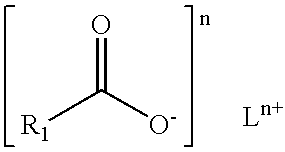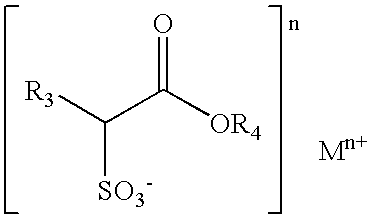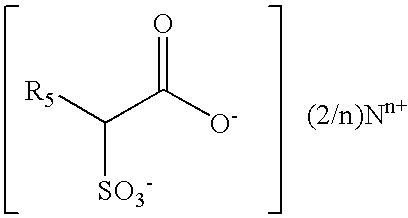Soap bar compositions comprising alpha sulfonated alkyl ester and polyhyridic alcohol and process for producing the same
a technology of alkyl ester and polyhyridic alcohol, which is applied in the preparation of detergent mixture compositions, detergent powders/flakes/sheets, detergent compounding agents, etc., can solve the problems of high lathering soap bars that fail in this respect, syndet bars often possess poor physical properties, and odors, etc., to improve processing efficiency, improve foaming properties, and improve the effect of performance and processing synergies
- Summary
- Abstract
- Description
- Claims
- Application Information
AI Technical Summary
Benefits of technology
Problems solved by technology
Method used
Image
Examples
example 1
Procedure for Making Cleaning Bar
[0076] One procedure for making soap / sulfonated methyl ester (SME) bars is as follows: [0077] (1) Neat soap is melted in a steam jacketed crutcher (18-200° F.): [0078] (2) Alpha sulfomethyl ester, as a dried paste or an aqueous solution, is added to the crutcher with stirring, and agitation contained for 5 minutes. [0079] (3) Additives to reduce tackiness, such as glycerine or sodium chloride (0.1 to 2.0%) can be introduced into the crutcher at this point and stirring continued for another 2 minutes. [0080] (4) The wet soap is air-dried or vacuum-dried to reduce the moisture level to below 5%. [0081] (5) To milled soap chips, perfume, titanium dioxide and other minor additives are added and milled again (this time with the crimper plate in position). [0082] (6) The soap mix is processed through a Beck plodder (commercially available from Stephan Beck Plodder Co). The temperature of the plodder is maintained at 90-100° F. using a water circulation sy...
example 2
Monosalt Sulfonated Methyl Ester (SME) MC-48 Preparation
[0084] MC-48 as defined above is commercially available from a variety of sources. Its method of manufacture is well known to those skilled in the art.
example 3
Disalt Sulfonated Fatty Acid (SFA) Preparation
[0085] Approximately 3500 grams of MC-48 acid is placed in a 4 L beaker and with rapid agitation, approximately 330 grams of sodium hydroxide is added slowly. Upon complete addition of the sodium hydroxide, the resulting SFA material had a thick, pasty consistency. The crude SFA is re-crystallized by washing with methanol, water and salting out the purified SFA product. The crude SFA is analyzed by titrating the material with 0.02N hyamine, which indicated that approximately 46.6% di-sodium salt of MC-48 is present. The recrystallized SFA product is approximately 99.8% di-sodium salt of MC-48.
PUM
| Property | Measurement | Unit |
|---|---|---|
| Temperature | aaaaa | aaaaa |
| Temperature | aaaaa | aaaaa |
| Temperature | aaaaa | aaaaa |
Abstract
Description
Claims
Application Information
 Login to View More
Login to View More - R&D
- Intellectual Property
- Life Sciences
- Materials
- Tech Scout
- Unparalleled Data Quality
- Higher Quality Content
- 60% Fewer Hallucinations
Browse by: Latest US Patents, China's latest patents, Technical Efficacy Thesaurus, Application Domain, Technology Topic, Popular Technical Reports.
© 2025 PatSnap. All rights reserved.Legal|Privacy policy|Modern Slavery Act Transparency Statement|Sitemap|About US| Contact US: help@patsnap.com



